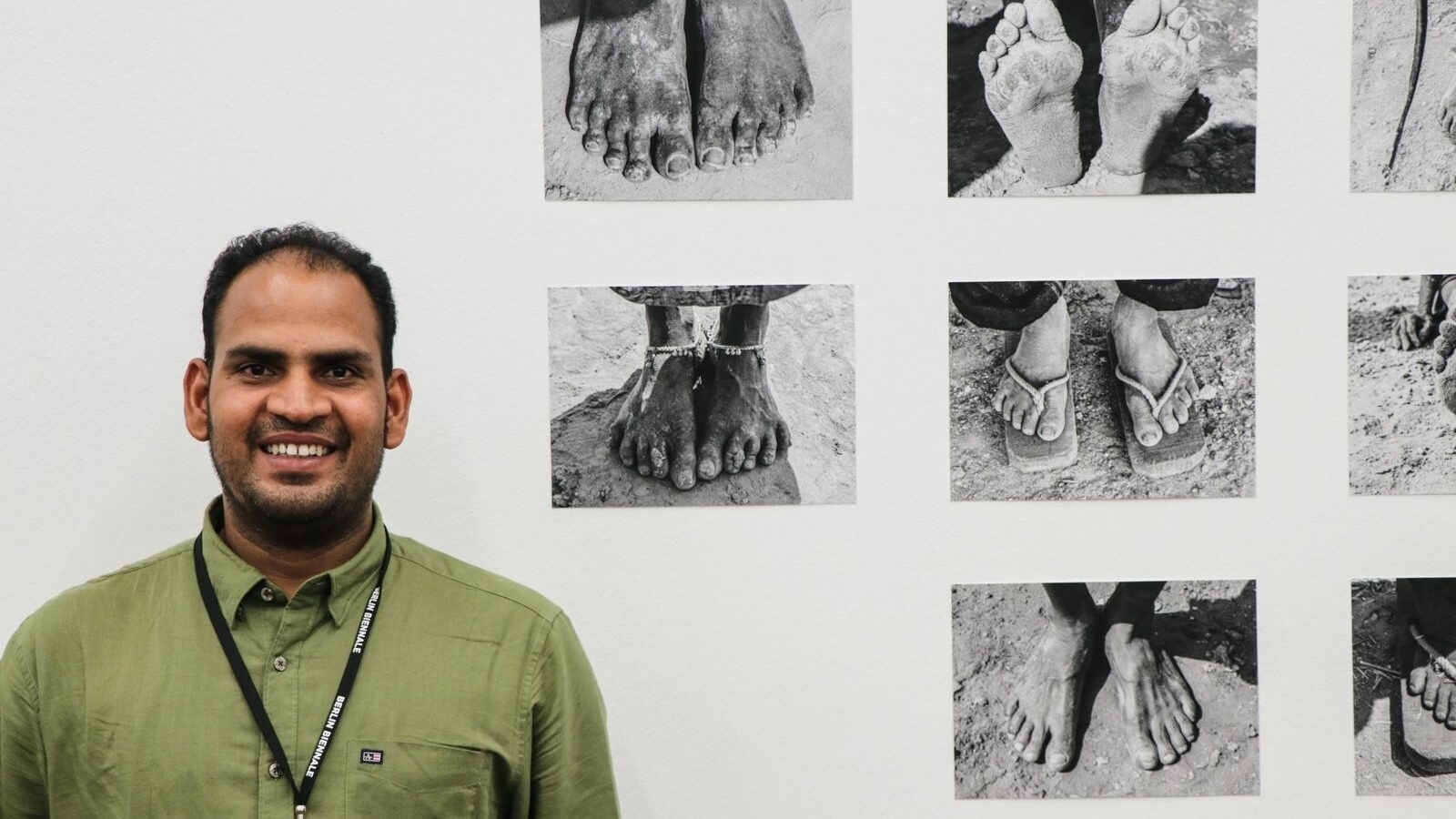Birender Yadav grew up in Dhanbad, Jharkhand, where his blacksmith father and uncles worked in nearby coal mines. At his school, his classmates also had relatives working in the mines.

Yadav, now 36, grew up to be an artist, having acquired an undergraduate degree and a master’s in fine arts from Banaras Hindu University and Delhi University. More than a decade of his art practice has focussed on labour and identity. He has also been regularly conducting art workshops for children of workers at brick kilns in Varanasi, Uttar Pradesh for the past eleven years.
Like Yadav, Himanshu Jamod learned about labour when, at the age of eleven, his father, a dockyard worker at Bhavnagar port in Gujarat, took him to the neighbouring shipbreaking yard. Jamod, who carried images of massive ships losing size and shape from their visit, joined the art school half a decade later.

A master’s in fine arts from Maharaja Sayajirao University of Baroda, Jamod uses the images of workers dismantling large ships in his paintings. Every week, he visits the port in his home town and the ship breaking units in nearby Alang to meet with his friends, who are part of the workforce in their dockyards.
Yadav and Jamod are among the 66 artists from 25 countries on the just-released list of participants at the sixth edition of the Kochi-Muziris Biennale, which begins on December 12.
Beginning from the backyard
The selection of artists for the much-delayed edition of the biennale to be held during December 12 to March 31 next year gives a hint of a stimulating future for Indian art laden with vigorous and probing art practices from the grassroots.
Curator Nikhil Chopra and the Goa-based art movement HH Art Spaces, co-founded by him, which had been entrusted with the unenviable responsibility of bringing the biennale back on the rails after a chaotic last edition in 2022 and a no-show last year, seem to have rested their curatorial ambition on the future of Indian art.
While the new edition has 66 participating artists and collectives, a sizeable proportion of artists from India have roots in remote villages or small towns, presenting a vastly different prospect compared to the previous biennale editions.
“Mostly gallery-represented artists used to participate in the biennale earlier,” says Yadav, who was born in Ballia, Uttar Pradesh, but moved to Dhanbad early in his childhood as his family searched for jobs. “We always saw the same artists at the art fair and biennale,” he adds. “This time, the participating artists at the biennale are mostly young and emerging artists. This will change the Indian art scene,” he adds.
Titled Only Earth Now They Are Labour, Yadav’s artwork uses terra cotta and wild clay, the main material of brick kilns. “The workers at brick kilns create the core material for new construction, the barometer of development of the country, but they are never remembered by society,” laments the artist.
Memory as metaphor
“Ship breaking is a metaphor of my work,” explains Jamod, who will be travelling to Fort Kochi, the main venue of the biennale, early next month to begin installing his artwork. “My father worked his whole life at the Bhavnagar dockyard, repairing parts of ships. He retired five years ago.”
“I am fascinated by the workers at the Alang ship breaking yard who cut large ships into pieces. Even a small part of the ship is bigger than a house. The workers cut a part of the ship and make a house for themselves to live inside the ship so that they can continue their work,” says Jamod. “My artistic imagination is derived from their labour.”
When the biennale opens in December, young and emerging artists like Yadav and Jamod, whose art practices are deeply influenced by the struggles of their families, friends and neighbours, are expected to paint a contrasting picture of the Indian art scene dominated by the art market.

Dhiraj Rabha, another participating artist of the biennale this year, spent his childhood in a camp for surrendered militants of United Liberation Front of Asom (ULFA), an insurgent group that waged a struggle to establish an independent nation for indigenous people in Assam.
“My father was a member of ULFA who surrendered in 1999. I was a young boy when my family came to live in a camp in Goalpara designated for surrendered militants. We still live there,” says Rabha, who went on to earn his bachelor’s and master’s degrees in painting at the Visva-Bharati University in Santiniketan, West Bengal.
“My family suffered a lot,” recalls Rabha, whose art practice is centred on memories of the insurgency in Assam. “I think it is important for art to talk about the realities of our society so that we can reclaim them. Even a small village has multiple realities,” adds the artist whose biennale installation will be based on three years of research on the insurgency.
Logic of land
Raja Boro is another artist from Assam selected to the biennale this year. Born in Rangia village of Assam’s Kamrup district, Boro’s art practice is heavily influenced by his picturesque village, where its residents rely on farming for livelihood.

“The landscape of memory is at the core of my work,” says Boro, who studied in Santiniketan as an undergraduate before studying for his master’s degree in printmaking from Baroda University. His printmaking work is based on the natural world, which evokes memories of growing up in a remote village whose residents worshipped nature.
Khageswar Rout, yet another participating artist, was born in Bhadrak district of Odisha in the Chadheya village on the banks of the majestic Sarandi river. “It is a beautiful cultural space filled with rivers and farms,” says Rout, who studied sculpture at Santiniketan.
“My primary source of influence was the vegetation and scenic beauty of nature in my village,” says Rout, who will be showing a set of sculptures in ceramic, porcelain and terra cotta and another set of drawings at the biennale.

“My work is about ambition and enquiries. When I see a plant, I want to know things, like formation, surface and texture. When I am sculpting a plant or drawing, I am searching for more information, both personal and social,” says Rout. “An object has a logic of formation, and that is my tool to stay in my world.”
Aditya Puthur, who, like Jamod and Boro, earned his master’s degree in fine arts from Baroda University, was inspired by the idea of body and death in his childhood. Born in the temple town of Ambernath near Thane in Maharashtra, Puthur wanted to understand the body from a clinical perspective.
The assassination of physician and rationalist Narendra Dabholkar, the founder of Maharashtra Andhashraddha Nirmoolan Samiti, in 2013 had a lasting impact on the young Puthur, who began to question the idea of the soul.
“The idea of soul promotes the ideas of superstition and rebirth,” says Puthur, whose work at the upcoming biennale titled Rosabella, Believe, originates from the story of American illusionist Harry Houdini, who wanted to expose psychics popular in the 1920s.
“Houdini made a pact with his wife, Bess, that if he could communicate with her after his death, he would use a code, which was Rosabella, believe,” says the artist. “Bess tried to communicate with her husband after his death in 1926, but she was never successful.”
The 2025 biennale, themed ‘For the time being,’ is expected to be a microcosm of India’s hinterland, where struggles are waged and dreams are made. The participating artists this year believe they are better placed to reflect that ground reality. Says Yadav, “As an artist, your practice is influenced by where you come from.”












